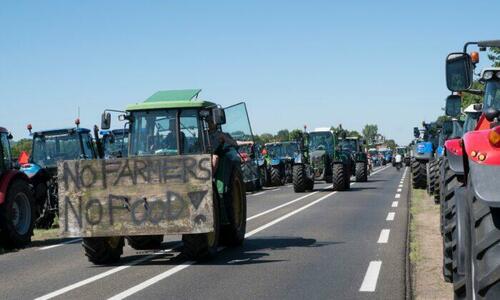Dutch Nitrogen Scientist Questions Basis Of Government Climate Mandates
Authored by Nathan Worcester via The Epoch Times (emphasis ours),
Jaap Hanekamp is skeptical of the received wisdom in science. He won’t stop asking a simple question: “But, is this true?”
When it comes to the Dutch government’s calculations of ammonia and nitrogen oxide deposition—the basis of climate mandates that would slash livestock numbers and put many farmers out of work—Hanekamp is especially critical of “the science.”
He thinks it relies on vague definitions, excessive deference to expert judgment, and a narrow focus on costs rather than both costs and benefits.
“We now treat farmers as polluters, end of story, which is a very strange perspective,” he said.
Hanekamp, an associate professor of chemistry at University College Roosevelt in the Netherlands, made the comments in an interview with Roman Balmakov, host of EpochTV’s “Facts Matter.”
A 2019 Dutch court decision that hindered the construction of livestock facilities triggered an earlier round of protests by farmers.
A Science article on the protests described some of the harms attributed to nitrogen emissions: “In 118 of 162 Dutch nature reserves, nitrogen deposits now exceed ecological risk thresholds by an average of 50 percent.
“In dunes, bogs, and heathlands, home to species adapted to a lack of nitrogen, plant diversity has decreased as nitrogen-loving grasses, shrubs, and trees move in.”
“Nitrogen chemicals are nutrients—you need them for growing plants,” Hanekamp said.
Hanekamp believes the government has focused on nitrogen almost to the exclusion of other factors that affect nature, such as the location of groundwater relative to the surface.
He also questions whether the ecosystem shifts prompted by greater nitrogen deposition can be properly defined as “damage.”
“Is a change in biodiversity bad in itself, or is it just change?” he asked.
He pointed out that the Netherlands is far from pristine wilderness. Much of the land is artificial, reclaimed from the sea over recent centuries thanks to the ingenuity of man.
Hanekamp has scrutinized a term used in government ecological research: “nitrogen critical load.”
Below its “critical load,” a substance is not thought to pose a significant environmental threat.
In a recent paper, Hanekamp and coauthor William Briggs described some problems with the evidence used to define nitrogen critical loads in the Netherlands.
For one thing, they do not believe the definitions of nitrogen critical loads are sufficiently precise. In addition, they think there have not been enough large-scale, long-term studies on nitrogen deposition.
Hanekamp stressed that models can be useful—taking 100,000 measurements across the country wouldn’t exactly be easy or cheap.
Yet modeling uncertainty makes it challenging to translate activity on a particular farm to exact patterns of nitrogen flow.
That hasn’t stopped the Dutch nitrogen minister from unveiling detailed, area-specific nitrogen reduction targets in June of this year.
The release was the impetus for the latest round of protests by farmers.
One dairy farmer interviewed by The Epoch Times would have to cut his livestock numbers by 95 percent—so much that he expects he will need to shut down.
Read more here…
Tyler Durden
Sun, 07/17/2022 – 07:00

